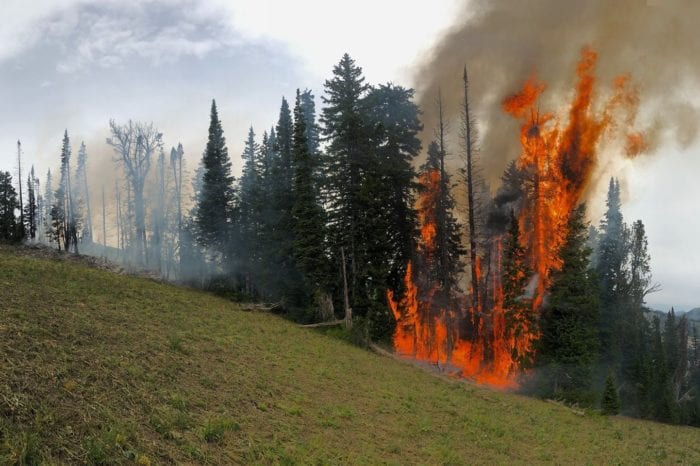Thick, billowing smoke often obscures the Tetons this time of year. But the skies are relatively clear in Northwest Wyoming. Still, fire managers point to human-caused fires as a concern even amid a mild fire season. Officials from the Bridger-Teton National Forest have counted 17 fires so far this summer. Six of those, or more than one-third, were human-caused. (The rest were ignited the natural way, by lightning strikes.) In fact, just this summer, Bridger-Teton officials have found 119 abandoned or unattended campfires, the No. 1 cause of wildfires that people start.
“Folks are always leaving campsites and just putting some dirt on the fire and think that it’s out, but it’s got to be out to the touch,” said Steve Markason, fire management officer for the Bridger-Teton National Forest. Markason said campers also have to douse campfires with cold water since those fires “can reignite later in the day with wind and carry into dry fuels adjacent to campsites.” Chainsaw use, disposing of lit cigarettes or driving ATVs on tall grass can also cause fires.
All of these behaviors are more consequential, Markason said, because of the current fire danger. Warnings are “high” in the Teton and Wind River ranges. In the Wyoming Range, the danger is “very high.” These warnings come at a time when the cost of fire management has sharply risen. Twenty years ago, firefighting only accounted for 16 percent of the Forest Service’s budget. Today, it commands more than half of its funding. From a Forest Service perspective, Markason said fire management has a “huge impact on other resource programs.”
In other words, when the Forest Service is strapped for cash during severe fire seasons, it draws money from other efforts and programs. That practice has become known as “fire borrowing.” But starting in 2020, a bipartisan bill signed into law by President Trump last year will end such moves of desperation. Next year the Forest Service will have access to an additional $2 billion per year for firefighting efforts.
One reason costs are rising? Climate change is transforming fire seasons. They have become longer, hotter and drier, Markason said. That puts added strain on firefighters and demands more resources for fighting fires.
Still, Markason likes to point out that living in the West means “living with fire.” In recent years, fires near the town of Jackson have underscored this truth. One is the recent fire near the Wildlife Museum and the other is the 2012 Horsethief Canyon Fire. Both forced some residents to evacuate. The Horsethief Canyon Fire’s flames were a disturbing sight as they jumped and swayed from the top of Snow King, a landmark in the town of Jackson flanked by homes, condos and apartments.
A lot of folks in Teton County, even if they don’t live in a forest or on the edge of “the Town Hill,” are living in what is called “the wildland-urban interface,” Markason said. In other words, they live near areas that can ignite and easily spread fire. For example, the Wildlife Museum fire shows that even if you’re not living on the edge of a forest, you’re still at risk. “That was a lightning-caused fire that ignited shrubs and bushes,” Markason said.
Two of the most recent fires in the area were human-caused: the Boulder Lake and Coburn fires. The former was sparked from people shooting at Tannerite, an explosive target. (That’s why fire officials first named it the Tannerite Fire.) Meanwhile, an abandoned campfire ignited the Coburn Fire. Both have been contained and are under federal investigation.
Markason said the number of unattended campfires forest officials have already doused this summer is indeed worrisome. When human-caused fires lead to destructive wildfires, the ramifications are vast and untold. Responsible parties also feel the pain, often in the form of massive fines, Markason said. For example, the man who started the Horsethief Canyon Fire, from burning trash in his yard, had to pay $2.9 million in restitution. As fire danger persists, Markason said the fallout from that fire is something to keep in mind.






